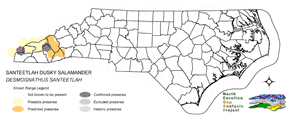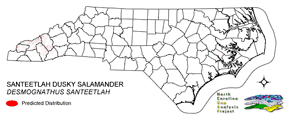
| Taxa: |
| Order: |
| Family: |
| Amphibia |
| Caudata |
| Plethodontidae |
| NatureServe Global Rank: |
| NatureServe State (NC) Rank: |
| G3Q |
| S2S3 |
| Federal Status: |
| NC State Status: |
| --- |
| SR |


| Land Unit |
| US Fish & Wildlife Service |
| US Forest Service |
| US National Park Service |
| US Department of Defense |
| NC State Parks |
| NC University System |
| NC Wildlife Res. Com. |
| NC Forest Service |
| NC Div. of Coastal Mgmt. |
| Local Governments |
| Non-Governmental Org. |
| Other Public Lands |
| Private Lands |
| GAP Status 1-2 |
| All Protected Lands |
| Statewide |
| Hectares |
| 0.00 |
| 9,788.76 |
| 0.00 |
| 8,574.30 |
| 0.00 |
| 0.00 |
| 110.97 |
| 2.13 |
| 0.00 |
| 0.00 |
| 86.85 |
| 0.00 |
| 9,007.83 |
| 10,232.52 |
| 18,563.01 |
| 27,570.84 |
| Acres |
| 0.00 |
| 24,188.55 |
| 0.00 |
| 21,187.55 |
| 0.00 |
| 0.00 |
| 274.21 |
| 7.78 |
| 0.00 |
| 0.00 |
| 214.61 |
| 0.00 |
| 22,258.83 |
| 25,287.62 |
| 45,872.71 |
| 68,131.54 |
| % of Dist. on |
| Prot. Lands |
| 0.0 % |
| 52.7 % |
| 0.0 % |
| 46.2 % |
| 0.0 % |
| 0.0 % |
| 0.6 % |
| < 0.1 % |
| 0.0 % |
| 0.5 % |
| 0.5 % |
| 0.0 % |
| 0.0 % |
| 55.1 % |
| ----- |
| ----- |
| % of Dist. on |
| All Lands |
| 0.0 % |
| 35.5 % |
| 0.0 % |
| 31.1 % |
| 0.0 % |
| 0.0 % |
| 0.4 % |
| < 0.1 % |
| 0.0 % |
| 0.0 % |
| 0.3 % |
| 0.0 % |
| 32.7 % |
| 37.1 % |
| ----- |
| ----- |
|
Populations are restricted to the Unicoi, Great Smoky, Great Balsam mountains of the southern Appalachians (Petranka 1998). Found near streams in mid and high-elevation hardwood and conifer forests (Wilson 1995). NATURE SERVE GLOBAL HABITAT COMMENTS: Stream headwaters and seepage areas, where ground water percolates to surface through muck, mossy rocks, impatians, and nettles. Under rocks in a few mm of water at margins of seeps, among gravel and cobble where water percolates. Eggs are laid mostly beneath mosses growing on rocks, on logs, or on soil surface. Nest sites 16-83 cm from nearest open water, commonly beneath mosses on logs lying in and around seepage areas (Jones 1986). |
| Code | Name | Description | NC Natural Heritage Program Equivalent |
| 521 | Spruce/Fir Forest | High Elevation Frazer-Fir - Red Spruce, Red Spruce and Red-Spruce-Yellow Birch Forests. Tree densities included here include both woodland to forest density. Highly intermixed with Northern Hardwoods, Grassy Balds, and Shrub Balds. | Red Spruce--Fraser Fir Forest, Fraser Fir Forest |
| 522 | Northern Hardwoods | High Elevation forests including yellow birch, American beech, and yellow buckeye. Includes forests with Hemlock and Yellow Birch. | Northern Hardwoods Forest, Boulderfield Forest |
| 525 | Appalachian Oak Forest | A variety of oak forest types including Black, White, Scarlet Oaks in dry to mesic situations. Includes forests historically co-dominated by American Chestnut. | High Elevation Red Oak Forest, Montane White Oak Forest |
| 526 | Appalachian Cove Forest | Mixed Mesophytic forests of the mountains. Includes tuliptree, basswood, yellow buckeye and surgar maple. This class is mapped to include cove forests dominated or co-dominated by hemlock. | Rich Cove Forest, Acidic Cove Forest |
| 527 | Appalachian Hemlock | Upland hemlock forests of the moutains region. Vary from side slopes to steep slope positions. | Canada Hemlock Forest |
|
Tilley, S. G. 1988. Hybridization between two species of DESMOGNATHUS (Amphibia:Caudata:Plethodontidae) in the Great Smoky Mountains. Herpetol. Monogr. 2:27-39.
Wilson, L. A. 1995. The Land Manager's Guide to the amphibians and reptiles of the South. Chapel Hill, NC: The Nature Conservancy. Petranka, J. W. 1998. Salamanders of the United States and Canada. Washington DC: Smithsonian Inst. Press. Tilley, S. G. 1981. A new species of DESMOGNATHUS (Amphibia:Caudata:Plethodontidae) from the southern Appalachian Mountains. Univ. Michigan Mus. Zool., Occas. Pap. 695:1-23. Jones, R. L. 1986. Reproductive biology of DESMOGNATHUS FUSCUS and DESMOGNATHUS SANTEETLAH in the Unicoi Mountains. Herpetologica 42:323-334. |
For more information please contact them at:
NC-GAP Analysis Project
Dept. of Zoology, NCSU
Campus Box 7617
Raleigh, NC 27695-7617
(919) 513-2853
www.basic.ncsu.edu/ncgap